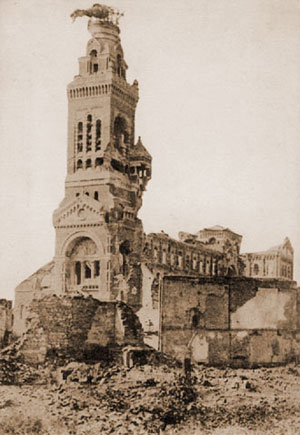Dieppe
Albert

The Basilica
Albert was the main town behind the lines for the Allies nearest to the 1916 Somme battlefields. It lies on the main D929 road that runs east to Bapaume across the Somme battlefields, and west to Amiens in the other direction (although the D929 now diverts to the south around Albert, the original road still runs through it).
For a town at the heart of the British activities in this region, there are surprisingly few Great War sights to see in Albert. Devastated during the war and rebuilt afterwards, it has to be said that it is not as attractive a city as Ypres. As a base for battlefield touring both accommodation and restaurants are fairly limited. However, it is an important location on the battlefield, and this page describes what there is to be seen.
In terms of the history of the war, Albert came to be associated with the British when their troops took over the lines here in the summer of 1915.
After the war, Albert was «adopted» by Birmingham. In the centre of Albert is one of the most famous icons for the British in the Great War - the Golden Virgin on top of the Basilica. The golden statue of the Madonna holding aloft her child was visible from far away, and of course was an excellent target for enemy artillery. It was damaged fairly early on, in January 1915, and the statue was knocked from its perch but stayed leaning at an angle before being secured by the French in that position.
A superstition grew up that the war would end only when the statue finally fell.
It remained, somewhat improbably, in the same position all the time that Albert was in French and then British hands.
The Germans advanced into Albert during their Spring Offensive in 1918, and well aware that the tower could be used as an excellent observation point by the Germans, it was British artillery that then deliberately targeted it and the statue finally fell.
Albert was retaken by the British (the 8th East Surreys) four months later, but it was another three months after this until the Armistice.